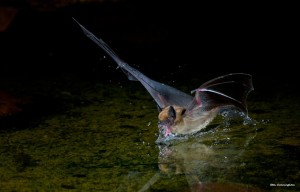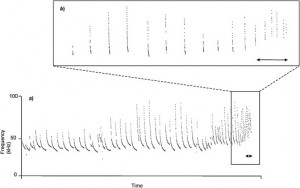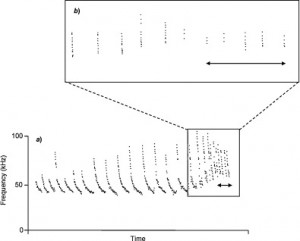Bats often fly above bodies of water from dusk to early evening to drink and forage. Foraging bats use ultrasonic pulses, sounds that are inaudible to us, that are regularly synced with wing beats and respiratory cycles to orient and locate prey. Bats emit a terminal buzz while drinking which are similar to those emitted while foraging. A terminal buzz is the last pulses of an echolocation call sequence. Echolocation is the use of calls to listen to the echo that will provide them with information about how far the object is away from them. So a terminal buzz sequence is the last pulses of sound produced before reaching an object. This study sought to discover the level to which bats produce terminal buzzes while drinking in flight.
Over 6 hours of recording bats at Birdlife Australia’s Gluepot Reserve, Waikerie, South Australia, 809 drinking passes (drinking while flying low over water) by bats were recorded. Only those which touched the water and left a visible ripple on the surface were included in the study. All 809 drinking passes were accompanied by a terminal buzz call emitted before they touched the water to drink. Out of all the buzzes, 21% were in the range of 36-50 kHz range and the remaining 79% were in the 25-35 kHz range. Figure 1 shows a pattern unique to Gould’s wattled bat Chalinolobus gouldii with search phase pulses from 28 kHz to 31 kHz. Figure 2 shows a pattern with an upward sweeping tail at 43 to 45 kHz. This pattern is likely to be produced by Vepadeslus baverstocki or Vepadeslus regulus. This difference in frequency proves that bat terminal buzz sequences are not all the same and in this case can be placed into two groups. The frequency of the terminal buzz can help determine the species present.
To hear the difference between these two terminal drinking buzzes click the links below.
Chanlinolobus gouldii (First in real time, then in half time) mmc1
Vespadelus sp. (First in real time, then in half time) mmc2
Drinking water while flying is a complex aerial maneuver. It requires very high precision and accuracy to avoid colliding with the waters’ surface. Bats that forage for insects produce a terminal buss to provide precise information about the size, shape and location of their prey. Bats also use this terminal buzz sequence to avoid obstacles in flight and to locate landing sites. Drinking buzzes provide the bat with spatiotemporal information to locate the surface before touching it with their mouth to drink. Drinking buzzes may be used in a similar fashion as foraging buzzes. This research suggests that other studies may overestimate the number of foraging buzz calls over water bodies if they were unaware of drinking buzz calls. Drinking buzzes can be used to document rates of drinking by bats in the future. The more we know about bats, the more we can do if they ever need our help.
Sources:
Cunningham, Stan. “Photographing Bats Drinking from Elephant Head Pond in Amado AZ.” Web blog post. Cunningham Outdoors LLC. N.p., 06 Dec. 2012. Web. 14 Feb. 2014.
Griffiths, S.R. 2013. Echolocating bats emit terminal phase buzz calls while drinking on the wing. Behavioral Processes 98:58-60.




Nice use of sound clips!